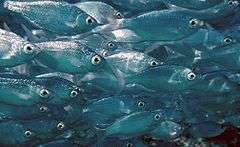Flagtail
The flagtails (āhole or āholehole in the Hawaiian language) are a family (Kuhliidae) of perciform fish of the Indo-Pacific area. The family consists of several species in one genus, Kuhlia. Most are euryhaline and often found in brackish water, but the genus also includes species restricted to marine or fresh water.
| Flagtail | |
|---|---|
 | |
| Hawaiian flagtail (K. sandvicensis) | |
| Scientific classification | |
| Kingdom: | Animalia |
| Phylum: | Chordata |
| Class: | Actinopterygii |
| Order: | Perciformes |
| Family: | Kuhliidae D. S. Jordan & Evermann, 1896[1] |
| Genus: | Kuhlia T. N. Gill, 1861[2] |
| Type species | |
| Perca ciliate G. Cuvier, 1828[2] | |
| Synonyms[3] | |
| |
Several species are known as Hawaiian flagtails, particularly K. sandvicensis and K. xenura.
| Wikimedia Commons has media related to Kuhliidae. |
Etymology
The genus Kuhlia is named for the German zoologist Heinrich Kuhl (1797–1821).[4]
Description
The distinctive characteristic of these fish is a scaly sheath around the dorsal and anal fins. The dorsal fin is deeply notched between the 10 spines and the 9 to 13 soft rays. The opercle has two spines, and the anal fin three. Their bodies are compressed and silvery, and they tend to be small, growing to 50 cm at most.
During the day, they usually school, dispersing at night to feed on free-swimming fish and crustaceans.
Species
The currently recognized species in this genus are:[5]
- Kuhlia caudavittata (Lacépède, 1802)A school of young Kuhlia caudavittata.
- Kuhlia malo (Valenciennes, 1831)
- Kuhlia marginata (G. Cuvier, 1829) (spotted or dark-margined flagtail)
- Kuhlia mugil (J. R. Forster, 1801) (barred flagtail)
- Kuhlia munda (De Vis, 1884) (silver flagtail)
- Kuhlia nutabunda Kendall & Radcliffe, 1912 (Rapanui flagtail)
- Kuhlia petiti L. P. Schultz, 1943
- Kuhlia rupestris (Lacépède, 1802) (rock flagtail, jungle perch)
- Kuhlia salelea L. P. Schultz, 1943
- Kuhlia sandvicensis (Steindachner, 1876) (Hawaiian flagtail)[6]
- Kuhlia sauvagii Regan, 1913
- Kuhlia xenura (D. S. Jordan & C. H. Gilbert, 1882)[6]
Timeline

References
- Mary Kawena Pukui and Elbert (2003). "lookup of āholehole". on Hawaiian dictionary. Ulukau, the Hawaiian Electronic Library, University of Hawaii. Archived from the original on December 28, 2012. Retrieved July 9, 2010.
- Mary Kawena Pukui and Elbert (2003). "lookup of āhole". on Hawaiian dictionary. Ulukau, the Hawaiian Electronic Library, University of Hawaii. Archived from the original on December 28, 2012. Retrieved July 9, 2010.
- Richard van der Laan; William N. Eschmeyer & Ronald Fricke (2014). "Family-group names of Recent fishes". Zootaxa. 3882 (2): 001–230.
- Eschmeyer, W. N.; R. Fricke & R. van der Laan (eds.). "Kuhlia". Catalog of Fishes. California Academy of Sciences. Retrieved 11 April 2020.
- Eschmeyer, W. N.; R. Fricke & R. van der Laan (eds.). "Kuhliidae genera". Catalog of Fishes. California Academy of Sciences. Retrieved 11 April 2020.
- Template:Kuhlia
- Froese, Rainer and Pauly, Daniel, eds. (2013). Species of Kuhlia in FishBase. August 2013 version.
- Randall, J.E. and H.A. Randall, 2001. Review of the fishes of the genus Kuhlia (Perciformes: Kuhliidae) of the Central Pacific. Pac. Sci. 55(3):227-256.